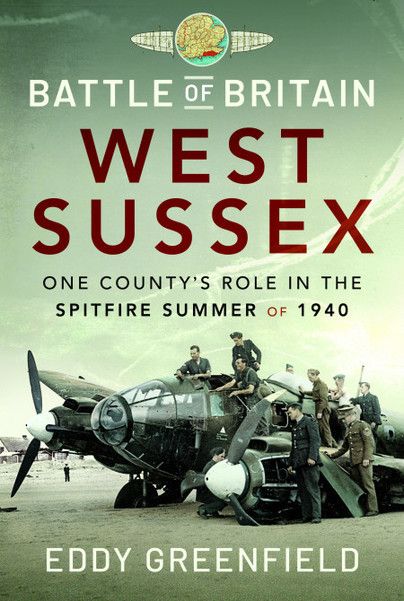Author Guest Post: Eddy Greenfield
6 Things You Didn’t Know About West Sussex and the Battle of Britain
The Battle of Britain is perhaps one of the most defining moments in the history of the Second World War, ultimately leading to the downfall of Nazi Germany. With an undefeated enemy on his western flank, Hitler was forced into a multi-front war whilst Britain was able to remain a launching pad for aerial and seaborne operations against occupied Europe. Often thought of as being fought principally over Kent and London, West Sussex played a major role in the campaign.
1. The first ever successful night-time radar interception occurred off West Sussex.
A single Blenheim of the newly-formed Fighter Interception Unit at Tangmere was scrambled at 23.00 on 22 July when the nearby Poling radar station picked up a contact over the Channel. With the ground controller guiding the Blenheim onto its target, it wasn’t long before Pilot Officer Morris spotted the silhouette of a Do 17 against the moon. The pilot was able to approach the enemy bomber undetected and strafed it with machine gun fire. The flaming bomber was seen to crash into the sea five miles off Bognor Pier shortly after midnight.

2. Biggin Hill in Kent is perhaps one of the best known Battle of Britain airfields, but what about West Sussex?
Aside from Tangmere, West Sussex tends to get overlooked despite the fact that it had one of the highest concentrations of military airfields in the UK. Yes, that’s right; with six active airfields in the summer of 1940 (and a seventh under construction) this was one of the major power houses of aerial warfare across southern England. Fighter Command, of course, had its bases at Tangmere and Westhampnett (Goodwood) but Shoreham Airport was also requisitioned as an emergency airfield, Ford was home to the Fleet Air Arm (and, from September 1940, Fighter Command), Thorney Island saw extensive use by Coastal Command, and Gatwick – then just a small grass airstrip – was used first by Army Co-operation Command liaising with the anti-aircraft batteries and other ground defences and later as the home for the night-fighters of 141 Squadron.

3. The Blitz was not confined to London.
In fact, up until 13 October 1940, West Sussex was among the most heavily bombarded region in the British Isles. Across the 114 days of the Battle of Britain, an estimated 1,267 high explosives, 1,370 incendiaries, sixty-two oil bombs, and one landmine were dropped on the county, although this is likely to be an underestimate. As a result of this, forty-seven civilians were killed and ninety more injured. It wasn’t until the final weeks of the campaign that the number of raids on London exceeded that on West Sussex; at one point the total number of air raid alerts at Bognor Regis outnumbered those on London by almost 100!

4. The Battle of Britain was not a purely defensive campaign.
While the Spitfires and Hurricanes of Fighter Command were busy patrolling the skies over the south coast, the Blenheims and Beauforts stationed at Thorney Island made daily raids against the German-held ports and airfields across northern and western France, as well as providing air cover and reconnaissance for seaborne operations against the occupied Channel Islands. Although Coastal Command suffered heavy casualties, their continual harassment of the German invasion forces, airfields, ports and transport infrastructure took the war back to the enemy.

5. Many of the airmen defending West Sussex were not actually British.
Despite its name, the Battle of Britain was very much an international affair with pilots of no less than sixteen nationalities serving in the RAF. Of these, servicemen from Australia, Barbados, Belgium, Canada, the Czech Republic, Ireland, Jamaica, Newfoundland, New Zealand, Palestine, Poland, South Africa, and the USA all served alongside their British comrades in and over West Sussex. There was even a pilot of German origin: Count Manfred Beckett Czernin had been born in Berlin in 1913 and was the son and nephew of members of the Austro-Hungarian government during the First World War. He later moved to England with his mother and served with distinction during the Battle of Britain, gaining a DSO, MC and DFC during the war.

6. German intelligence was rubbish, right?
Wrong. Although the Luftwaffe High Command certainly underestimated the importance of British radar, and some of the military planning for Operation Sea Lion was rather fanciful, the Nazi’s weren’t at all lacking in detailed information. Tangmere and Thorney Island were among the first nine airfields in the UK to be given decoys – Gumber Farm (Slindon) for the former and West Wittering for the latter. However, although West Wittering seemed to have done its job in drawing bombers away from the airfield, invasion maps of West Sussex, as well as aerial reconnaissance photographs, clearly label Gumber Farm as a decoy from the outset.
Furthermore, while the actual operational plans for an invasion would certainly have resulted in an almost instant failure should Operation Sea Lion have been put into effect, the prior intelligence was extremely detailed. Maps – captured after the war – pinpoint all major military and industrial sites across West Sussex while detailed photos were obtained of the entire coastline, as well as specific inland targets such as Balcombe Viaduct. One rather humorous lapse, however, is that Christ’s Hospital School near Horsham was believed to have been an actual hospital.

…………………………………………………………………………………………………….

You can preorder a copy of Battle of Britain. West Sussex here.

